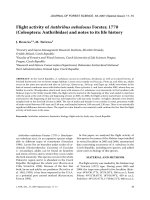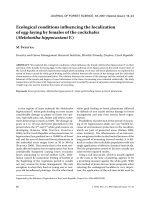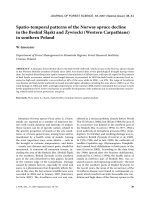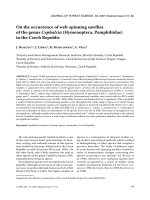Báo cáo lâm nghiệp: "Molecular markers provide evidence for long-distance planting material transfer during plantation establishment of Dalbergia sissoo Roxb. in Nepal" pot
Bạn đang xem bản rút gọn của tài liệu. Xem và tải ngay bản đầy đủ của tài liệu tại đây (151.09 KB, 4 trang )
603
Ann. For. Sci. 61 (2004) 603–606
© INRA, EDP Sciences, 2004
DOI: 10.1051/forest:2004056
Note
Molecular markers provide evidence for long-distance
planting material transfer during plantation establishment
of Dalbergia sissoo Roxb. in Nepal
Madhav PANDEY*, Oliver GAILING, Ludger LEINEMANN, Reiner FINKELDEY
Institute of Forest Genetics and Forest Tree Breeding, Georg-August-University Goettingen, Buesgenweg 2, 37077 Goettingen, Germany
(Received 16 May 2003; accepted 6 November 2003)
Abstract – We investigated five population pairs of Dalbergia sissoo in Nepal for variation of cpDNA and at the isozyme gene locus Gdh-A.
Each population pair consisted of one natural population and a neighboring plantation. Two or three different cpDNA-haplotypes were observed
in each population with a total of eight different haplotypes. The differentiation of cpDNA haplotypes between the group of natural populations
and the group of plantations was almost complete. Thus, the plantations did not originate from any of the investigated natural populations, but
reproductive material was transported over long distances during plantation establishment. All plantations proved to be fixed at the Gdh-A gene
locus, which showed considerable polymorphism in natural populations indicating different adaptive potentials of plantations and natural
stands.
cpDNA haplotpyes / isozymes / tropical tree / seed transfer / adaptive potential
Résumé – Mise en évidence de transferts à longue distance de matériel de reproduction utilisé pour des plantations de Dalbergia sissoo
Roxb. au Népal par l’utilisation de marqueurs moléculaires. On a étudié la variabilité d’ADNcp et de l’isozyme du locus Gdh-A dans cinq
paires de populations de Dalbergia sissoo situées au Népal. Chaque paire comportait une population naturelle et une plantation située à
proximité ; on a observé l’existence de deux ou trois ADNcp haplotypes dans chaque population avec, au total, huit haplotypes différents. La
différenciation pour les ADNcp haplotypes entre le groupe des populations naturelles et celui des plantations était presque générale. Il en résulte
que les plantations ne sont pas issues des populations naturelles étudiées ; le matériel de reproduction a été transporté sur de longues distances
au cours des opérations de plantation. Aucune variation du niveau du locus du gène Gdh-A n’a été trouvée pour toutes les plantations, alors qu’il
existe un polymorphisme considérable dans les populations naturelles. Il en résulte un potentiel d’adaptation différent entre plantations et
peuplements naturels.
haplotypes ADNcp / isozymes / arbre tropical / transfert de graine / potentiel d’adaptation
1. INTRODUCTION
The significance of forest tree plantations for the production
of wood rapidly increases throughout the tropics. The annual
increase of the plantation area in tropical Asia has been more
than two million hectares during the last decade [3]. Thus, the
biodiversity harboured in plantations of tropical trees and the
adaptive properties of tree populations used for plantation esta-
blishment are topics of growing importance. The genetic diver-
sity and the adaptive potential of plantations mainly depends
on the reproductive material used for plantation establishment.
The marketing of forest reproductive material is controlled
by legal regulations in industrialized countries [6]. However,
comparable regulations do not exist or are not enforced in most
developing tropical countries. Costs for procurement is usually
the decisive factor for the choice of seeds or other reproductive
material. As a result, the origin of material used for plantation
establishment is usually unknown in the tropics both for exotics
and species native to a planting region. A “narrow genetic
base”, i.e. low levels of genetic variation, and a poor adaptation
of the chosen reproductive material to environmental condi-
tions at the planting site are among the most frequently quoted
reasons for disappointing performance or even complete failure
of plantations [10].
Dalbergia sissoo Roxb. (Fabaceae) is naturally distributed
on the foothills of the Himalayas stretching from Afghanistan
to Bangladesh. The species is widely planted throughout its nat-
ural distribution, but also worldwide as an exotic [12]. It is a
* Corresponding author:
604 M. Pandey et al.
moderately fast-growing multipurpose species with an excel-
lent wood for furniture making and many other uses. D. sissoo
is currently one of the most frequently planted trees in Nepal
and has a long history of plantation establishment in the coun-
try. More than 40% of all forest trees planted in Nepal and more
than 90% of all trees planted in the flat “Terai” region of Nepal
are D. sissoo. However, many plantations have been seriously
affected by a die-back disease of unknown cause in the recent
past, and phenotypic characteristics such as stem form and
branching habit are often inferior in plantations. The origin of
D. sissoo plantations in Nepal is usually unknown. Today’s
occurrence of the species in natural forests in Nepal is restricted
to a few fragmented relics of autochthonous populations.
Molecular gene markers can be powerful tools to assess the
evolutionary past of populations [9] and to infer the origin of
material, which has been transferred by humans. We used
molecular markers to conclude on the origin of D. sissoo plan-
tations in Nepal. In particular, we addressed the following ques-
tion: Is there evidence for long-distant transfer of seeds for
plantation establishment?
2. MATERIAL AND METHODS
2.1. Plant material
Material was collected in five population pairs (A–E, Fig. 1). Each
pair consists of one natural population and one neighboring plantation.
The population pairs are located along a east-west transect in the flat
“Terai” region of Nepal. The size of populations vary from about one
hundred to several hundreds adult trees.
In each population we collected seeds from ten widely separated,
randomly chosen, mature seed trees. Seed trees had a diameter of at
least 20 cm and were estimated to be at least twelve years old. Seeds
of single trees were carefully kept separately. In natural population
Hattisar we were only able to sample seeds from six seed trees. We
assessed the cpDNA haplotype of one seed per investigated tree. Thus,
a total of 96 haplotypes were investigated. Five seeds per tree (total:
480 seeds) were investigated at the isozyme gene locus Gdh-A.
2.2. Methods
DNA was extracted from seeds using the QIAGEN DNeasy Plant
Mini Kit following the manufacturer’s instructions. The extracted
DNA was used for PCR-RFLP and microsatellite (cpSSR) analysis.
The isolated DNA samples were amplified with five different uni-
versal primers (trn L/F, trn D/T, trn L/T, trn K1/K2, trn T/F) for PCR-
RFLP analysis [2, 11]. PCR was conducted according to Demesure
et al. [2] with minor modifications. The total volume used for PCR was
25 µL: 2 µL template DNA (20 ng), 2 µL primer (0.5 µM of each
forward and reverse), 2 µL 10× PCR buffer with 2.5 mM MgCl
2,
6.5 µL distilled H
2
O, 12.5 µL Qiagen Master Mix, 1 Unit of Taq-DNA
polymerase (Hotstar Taq polymerase from Qiagen). Initial denatura-
tion was at 94 °C for 15 min, followed by 35 cycles, each consisting
of 94
°C for 1 min, 51
°C to 64
°C for 1 min, and 72 °C for 2 min. After
successful amplification, the PCR products were used for restriction
analysis with four to seven enzymes for each primer pair (trn L/F:
Taq I, Hae III, Hinf I, Rsa I, Alu I, Hpa II, Cfo I; trn D/T: Taq I, Hae III,
Hinf I, Rsa I, Alu I, Trn 9 I; trn L/T: Taq I, Hae III, Hinf I, Rsa I, Alu I,
Trn 9 I; trn K1/K2: Hae III, Hinf I, Rsa I, Alu I; trn T/F: Hae III, Hinf I,
Rsa I, Alu I, Hpa II, Cfo I). The total volume per sample was 11 µL
(7.0 µL PCR product + 1.5 µL enzyme (10 U/µL) + 1.5 µL buffer (10×)
+ 1 µL distilled H
2
O) for the restriction analysis. The restriction probes
were incubated at 65
°C for Taq I and Trn 9 I, and for all other enzymes
at 37
°C for about 16 h. PCR-RFLP products were separated in a 10%
polyacrylamide (PAA) gel with a length of 24 cm. The fragments were
visualized by SYBR Gold nucleic acid gel staining and photographed
with a digital camera.
Chloroplast microsatellites (cpSSRs) were amplified as described
by Weising and Gardner [14] using their universal primers ccmp-6,
ccmp-7, and ccmp-10. The preparation of the PCR-mix and the sepa-
ration and visualization of the fragments followed the procedures des-
cribed for PCR-RFLPs.
Horizontal starch gel-electrophoresis was used to investigate varia-
tion at isozyme gene loci. Only results obtained for glutamate-dehy-
drogenase (Gdh; E.C. 1.4.1.2) are reported here. Gdh isozymes were
Figure 1. Location of the investigated population
pairs of Dalbergia sissoo in Nepal. A: Hetauda
natural population and Hetauda plantation; B:
Shivapur natural population and Surai plantation;
C: Hattisar natural population and Thakurdwara
plantation; D: Godawari natural population and
Attaria plantation; E: Pipariya natural population
and Shuklaphanta plantation.
Long distance planting material transfer in Dalbergia sissoo 605
extracted from seeds and separated in a tris-citric acid buffer (pH 7.4)
[4]. Staining followed Vallejos [13] with slight modifications.
2.3. Data analysis
Interpretation of gels was done visually directly on the gels (iso-
zymes) or on the digital photographs (cpDNA fragments). Presence
or absence of cpDNA fragments was recorded as (1) and (0), respec-
tively, in a matrix. Trees showing no differences at all investigated
cpDNA fragments (PCR-RFLP and cpSSR) were grouped to the same
cpDNA haplotype. We refrained from a phylogenetic analysis of dif-
ferent chloroplast haplotypes since we used both PCR-RFLP and
cpSSR polymorphisms for this study and due to the restricted geogra-
phic range covered by our survey. Phylogenetic relationships among
haplotypes may considerably change if data from other regions
become available.
Differentiation of haplotypes among populations was measured as
F
ST
[7] for the five natural populations and the five plantations alone,
and for all ten populations taken together.
Isozyme phenotypes were interpreted as being controlled by a sin-
gle gene locus. The number of alleles observed (A) was recorded and
the expected heterozygosity (H
e
) was computed as for
each population [1].
3. RESULTS
Variation of PCR-RFLPs was observed after restriction of
the amplified fragment Trn K1/K2 (approximately 2700 bps)
with Alu I and Rsa I, respectively. All other primer-enzyme
combinations resulted in monomorphic patterns. Variation of
cpSSRs was observed for ccmp-6 and ccmp-7, but not for
ccmp-10. The observed variation allowed to distinguish eight
different haplotypes. All populations proved to be polymorphic
with two or three haplotypes identified for each population
(Tab. I). The differentiation between haplotypes of natural
populations (haplotypes 1–3) and of plantations (haplotypes 4–
8) was almost complete. Only one tree of the natural population
Pipariya showed haplotype 4, which was otherwise observed
in plantations only. The plantation Hetauda showed a diagnos-
tic fragment common to all trees of this population but to no
other tree if the Trn K1/K2 fragment was digested with Rsa I.
Differentiation among populations accounted for 50.5% of
the total variation of cpDNA haplotypes of all ten populations
(F
ST
= 0.505). The comparable F
ST
-values were 0.464 for the
five natural populations, and 0.286 for the five plantations only.
No variation was observed at the Gdh-A gene locus in any
of the plantations after investigation of 50 seeds per population
(Tab. I). However, all natural populations proved to be poly-
morphic with two to four alleles at this gene locus. All planta-
tions were fixed on allele Gdh-A
3
. This allele was also most
common in all natural populations.
4. DISCUSSION
We assume the cpDNA of D. sissoo to be maternally inhe-
rited since this mode of inheritance has been described for most
other angiosperm plants [5]. We observed considerable varia-
tion of cpDNA haplotypes within all studied populations. In
consequence, the contribution of differentiation among popu-
lations to the total diversity of cpDNA haplotypes (F
ST
) is
lower for D. sissoo as compared to several other tree species
such as European oaks (Quercus spp.) [9]. This may be explained
by the presumably efficient zoochorous dispersal of diaspores
resulting in high rates of seed migration among populations [8].
Differentiation of haplotypes among the two groups of natu-
ral populations and plantations is almost complete, i.e. the two
groups of populations do not share their haplotypes. The only
exemption to this observation is a tree in natural population
Pipariya showing haplotype 4, which is otherwise observed in
plantations only. It cannot be ruled out that this tree migrated
from a neighbouring plantation, possibly plantation Shukla-
phanta, to the natural relic forest.
We interpret the observation of almost complete differenti-
ation of cpDNA-haplotypes between plantations and natural
populations as a clear indication of substantial long-distant seed
transfer by humans in Nepal. Not only the nearest natural popu-
lation, but all investigated natural populations do not qualify
as a possible origin of any of the studied plantations. Currently,
we cannot identify the likely origin of D. sissoo plantations in
Nepal due to the largely unknown, but presumably long history
of plantation establishment in the country and due to a lack of
comparable data from other regions of the species’ distribution.
An origin from meanwhile extinct Nepalese populations cannot
be ruled out. However, long-distant transfer of reproductive
material from other countries is a more reasonable explanation
for the differentiation of cpDNA haplotypes. There is circums-
tantial evidence for a substantial import of D. sissoo seeds from
India in the past.
Looking only at natural forests, haplotype 1 is most common
in the eastern populations (A–C) of the transect, while haplo-
type 3 is dominating in the two western populations (D and E).
Results indicate a clinal variation with decreasing frequencies
of haplotype 1 from East to West. However, the number of
Table I. Number of observed cpDNA haplotypes and genetic varia-
tion at the Gdh-A isozyme gene locus (A: number of Alleles; H
e
:
expected heterozygosity) in five natural populations and five planta-
tions of Dalbergia sissoo in Nepal.
Pair Population
cpDNA haplotypes Gdh-A
12345678 AH
e
Natural populations
A Hetauda N 9 1 3 0.097
B Shivapur 8 2 4 0.317
C Hattisar 5 1 4 0.436
D Godawari 4 6 3 0.059
E Pipariya 9 1 2 0.368
Plantations
A Hetauda P 4 6 1 0
BSurai 17210
C Thakurdwara 4 3 3 1 0
D Attaria 6 4 1 0
E Shuklaphanta 5 5 1 0
∑
−=
i
ie
pH
2
1
606 M. Pandey et al.
investigated populations is insufficient to investigate the spatial
structure of cpDNA variation for natural populations in detail.
No comparable pattern seems to exist for the plantations.
The observation of a diagnostic PCR-RFLP fragment com-
mon to all trees of plantation Hetauda which was not observed
in any other population is interpreted as evidence for a different
origin of this plantation as compared to the others. The intro-
duction of material with different origin increased the total
variation of cpDNA found in plantations.
The observation of differentiation between natural popula-
tions and plantations not only at presumably maternally inhe-
rited cpDNA, but also at the biparentally inherited Gdh-A
isozyme gene locus confirms the impact of long-distant seed
transport during the establishment of plantations on their gene-
tic structures. The complete fixation of Gdh-A gene locus in
plantation could be either due to selection or adaptation or for
example due to the collection of planting material in a natural
stand that was fixed for the same allele. Another cause might
be collection of planting material from a reduced number of
mother trees in a polymorphic natural stand. Natural popula-
tions and plantations could have different evolutionary adap-
tive potentials at least at this locus.
The susceptibility of plantations to a die-back disease and
the frequently disappointing growth and stem form of D. sissoo
in plantations in Nepal have been explained by the use of pre-
sumably poorly adapted reproductive material. Our results sup-
port this view by providing evidence for long-distance seed
transfer during plantation establishment.
Small relics of autochthonous populations in natural forests
are surrounded by large D. sissoo plantations in Nepal. We pro-
ved considerable genetic differentiation between natural
forests and plantations. Thus, unidirectional gene flow through
pollen or seed from plantations to natural populations may con-
siderably change genetic structures of the natural relic popula-
tions. In this situation, the efficiency of efforts to conserve
genetic resources of D. sissoo in situ may be limited in Nepal.
We propose to implement complementary ex situ conservation
methods such as the establishment of provenance resource
stands in widely isolated regions, possibly out of the country.
Our results illustrate the utility of molecular methods to
investigate the history and adaptive potential of plantations
even in the absence of comprehensive data sets on variation pat-
terns in natural populations. Further studies involving material
from other regions of the species’ distribution may allow to gain
additional insights in the human impact on genetic structures
due to long-distant seed transfer.
REFERENCES
[1] Berg E.E., Hamrick J.L., Quantification of genetic diversity at allo-
zyme loci, Can. J. For. Res. 27 (1997) 415–424.
[2] Demesure B., Sodzi N., Petit R., A set of universal primers for
amplification of polymorphic non-coding regions of mitochondrial
and chloroplast DNA in plants, Mol. Ecol. 4 (1995) 129–131.
[3] FAO, State of the World’s Forests, FAO, Rome, 2001.
[4] Leinemann L., Bendixen K., Inheritance of isozyme variants in
field maple (Acer campestre L.), For. Genet. 6 (1999) 73–77.
[5] McCauley D.E., The use of chloroplast DNA polymorphism in stu-
dies of gene flow in plants, Trends Ecol. Evol. 10 (1995) 198–202.
[6] Nason A., The new OECD scheme for the certification of forest
reproductive material, Silvae Genet. 50 (2001) 177–280.
[7] Nei M., Analysis of gene diversity in subdivided populations, Proc.
Natl. Acad. Sci. USA 70 (1973) 3321–3323.
[8] Oddou-Muratorio S., Guesnet D., Ozdemir E., Petit R.J., Demesure
B., Patterns of seed dispersal in a scattered forest tree species (Sor-
bus torminalis) based on multi-scale investigation of population
genetic structure for chloroplast DNA, in: Müller-Starck G., Schu-
bert R. (Eds.), Genetic Response of Forest Systems to Changing
Environmental Conditions, Kluwer, Dordrecht, The Netherlands,
2001, pp. 271–280.
[9] Petit R., Csaikl U., Bordács S. et al., Chloroplast DNA variation in
European white oaks. Phylogeography and patterns of diversity
based on data from over 2600 populations, For. Ecol. Manage. 156
(2002) 5–26.
[10] Sim B.L., The genetic base of Acacia mangium Willd. in Sabah, in:
Barnes R.D., Gibson G.L. (Eds.), Provenance and Genetic Impro-
vement Strategies in Tropical Forest Genetics, Commonwealth
Forestry Institute and Forest research Centre, Oxford and Harare,
1984, pp. 597–603.
[11] Taberlet P., Gielly L., Pautou G., Bouvet J., Universal primers for
amplification of three non-coding regions of chloroplast DNA,
Plant Mol. Biol. 17 (1991) 1105–1109.
[12] Tewari D.N., A monograph on Dalbergia sissoo Roxb., Internatio-
nal Book Distributors, Dehra Dun, India, 1994.
[13] Vallejos C.E., Enzyme activity staining, in: Tanksley S.D., Orton
T.J. (Eds.), Isozymes in Plant genetics and breeding, Part A, Else-
vier, Amsterdam, 1983, pp. 469–516.
[14] Weising K., Gardner R.C., A set of conserved PCR primers for the
analysis of simple sequence repeat polymorphisms in chloroplast
genomes of dicotyledonous angiosperms, Genome 42 (1999) 9–19.









